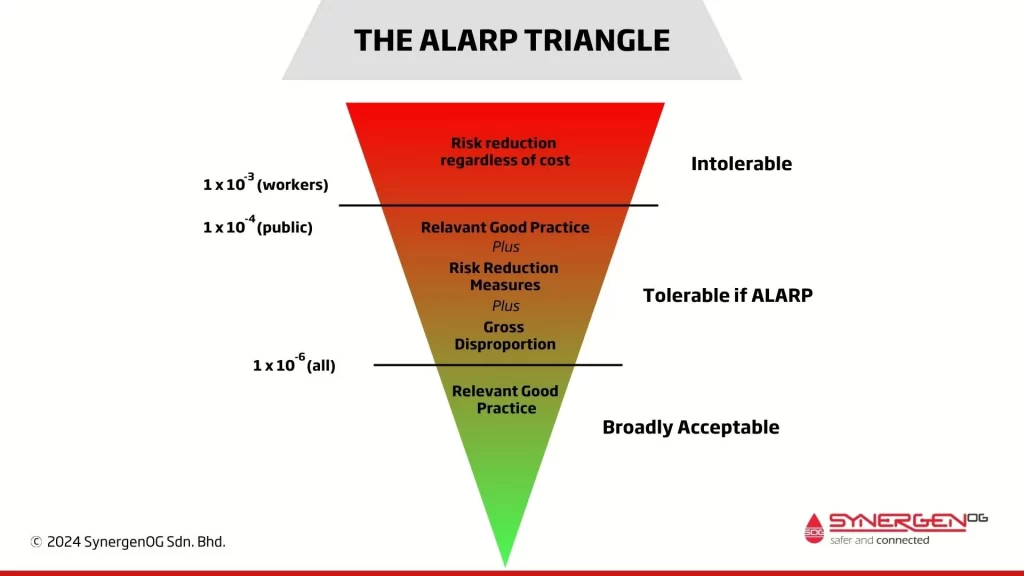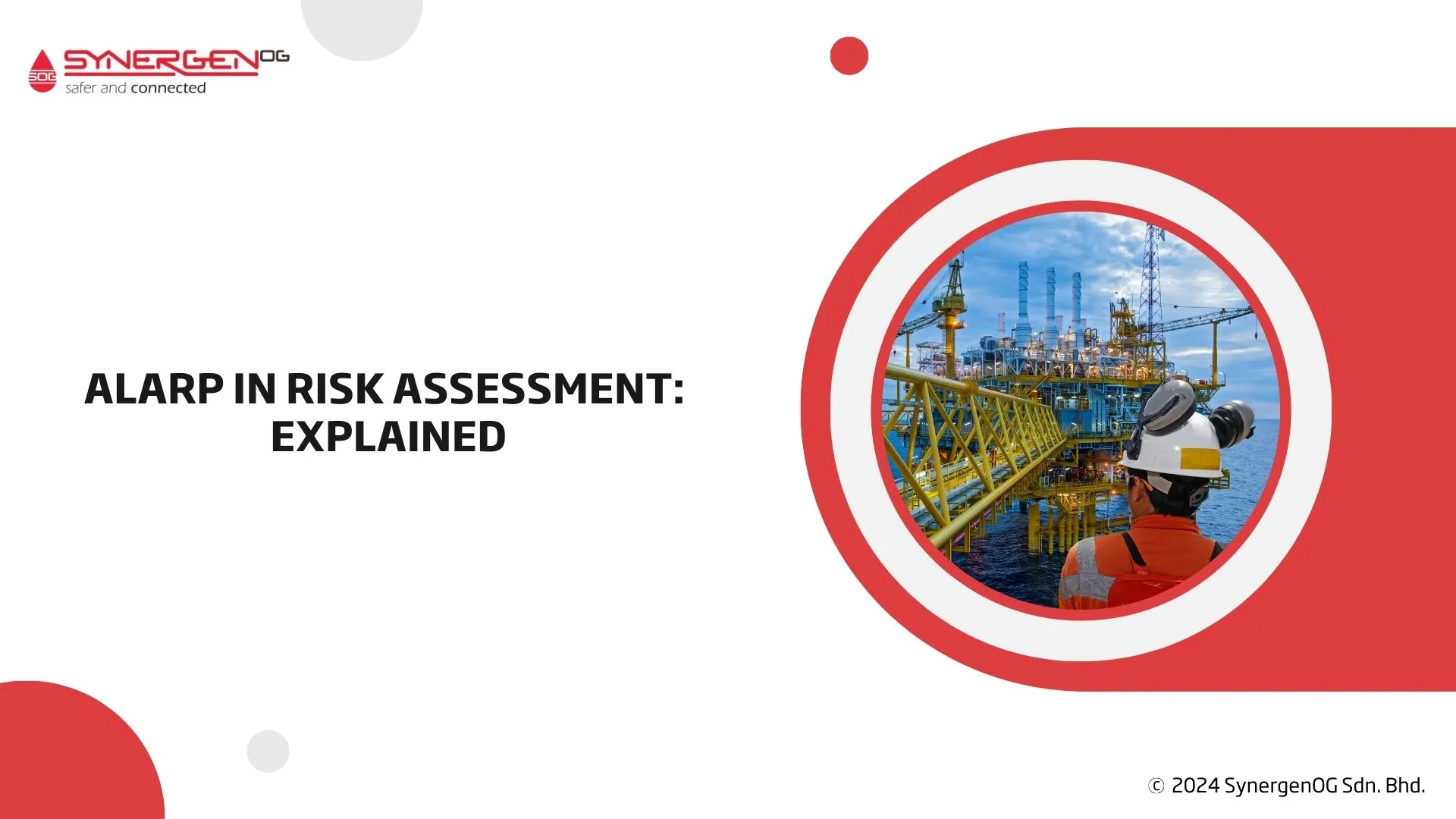| Summary: What is the significance of ALARP in risk assessment, and how does an ALARP assessment aid in maintaining risks at levels that are as low as reasonably practicable? What is the process of analyzing risk contributors and the necessity of determining additional risk reduction measures, following the ALARP principles outlined in the ALARP triangle? Here is a brief. |
ALARP – “As Low As Reasonably Practicable” is a term used in risk management to signify the level to which we expect to see workplace risks controlled. It is a concept used to assist in deciding which of the physically possible risk reduction measures should be adopted by weighing risk reduction against the trouble, time, and money needed to implement it.
Historical Background and Regulatory Framework
The ALARP principle emerged as a fundamental component of the Health and Safety at Work, etc. Act of 1974 which is a primary piece of legislation covering occupational health and safety in the UK. The principle has since guided many sets of health and safety regulations. In summary, this act states the following, with regards to ALARP:
It shall be the duty of every employer to ensure, so far as is reasonably practicable, the health, safety and welfare at work of all his employees. Eliminating risk as far as reasonably practicable includes the addressing following matters:
- Provision and maintenance of plant and systems
- Arrangements for use, handling, storage and transportation of substances
- Information, instruction, training and supervision
- Entrance to and egress from any place of work
- Provision and maintenance of working environment and facilities for welfare at work
Starting Point of ALARP
A good place to start when ensuring ALARP is to conduct design and operations according to acknowledged industry standards of good practice. These standards are defined through a consensus-building process with stakeholders, including employers, associations, government departments, and health and safety professionals. This is called the prescriptive approach to risk management.
The prescriptive approach of risk management is often considered the minimum requirement for design and operations of a facility. However, the prescriptive approach is not sufficient to demonstrate that risks have been reduced to ALARP. In order to move to the next level of ALARP, the question must be asked, “What else can be done to reduce risks to ALARP?” However, instead of focusing our efforts equally on all risks, we need a tool to help us focus on the significant risk contributors.
Identifying Significant Risk Contributors
1. Identifying Hazards
A hazard, as described by HSE, is anything that can cause adverse effects, such as an object, property of a substance, phenomenon, or activity. Identifying these hazards is the first step in any risk assessment process.
The identification process involves an evaluation of the workplace to spot these potential sources of harm, a task that requires diligence and understanding of the work environment. The most common tool used for the identification process is the Hazard Identification (HAZID) worksheet.
2. Evaluating the Risks
Risk involves the likelihood that a hazard will cause its adverse effects, together with a measure of the impact to humans, environment, asset and reputation. Evaluating this risk requires understanding both the probability of the hazard causing harm and the severity of the potential damage.
Expressions of risk could be probabilistic, like one in a thousand chances, or qualitative, such as negligible or significant.
Example, – The annual risk of a worker experiencing a fatal accident at work.
Evaluation will often involve both qualitative judgment and quantitative measures, drawing on a range of data and operational knowledge.
Read: Qualitative Vs Quantitative Risk Assessment
Identifying Further Risk Reduction Measures
After identifying the potential hazards and evaluating the associated risks, the next step involves identification of the existing risk reduction measures. A Hazard Register is a common tool to summarise all the hazards and their associated existing risk reduction measures. These existing risk reduction measures are often in place due to the compliance of design and operations to the industry standards of good practice as discussed above. With focus on the significant risk contributors identified above (risks that can give rise to significant injuries or fatalities, asset or environmental damage), further risk reduction measures are identified. These measures can be identified through workshops and third party safety studies.
How to Determine What is “Reasonably Practicable”
The decision must favour health and safety, implying that the presumption is for the duty-holder to implement the risk reduction measure. To refrain from making such sacrifice, duty-holders must demonstrate that it would be grossly disproportionate to risk reduction benefits.
A key judgment made in Edwards v. National Coal Board (1949) helps to define this term by stating:
“Reasonably practicable is a narrower term than physically possible … a computation must be made by the owner in which the quantum of risk is placed on one scale and the sacrifice involved in the measures necessary for averting the risk, whether in money, time or trouble, is placed in the other, and that if it is shown that there is a gross disproportion between them – the risk being insignificant in relation to the sacrifice – the defendants discharge the onus on them.”
1. The ALARP Triangle

To guide employers to decide and the extent of implementation of risk reduction measures, UK HSE has adopted the ALARP Triangle which equates Individual Risk Per Annum (IRPA), the annual risk of a worker experiencing a fatal accident at work – with the ALARP requirements. The numbers in the following figures are IRPA number expressed in fatalities/ year. In broad terms, if a worker has 0.000001 probability of fatality in a year, compliance to industrial good practices and codes is sufficient to demonstrate ALARP. If a worker has more than 0.001 probability of fatality in a year, additional risk reduction measures must be taken to reduce the risk to ALARP. For anything in between, risk reduction measures should be considered based on the above definition of ALARP. Note that the UK HSE criterion is only a guide and some operators have chosen more stringent criterion than this.
2. The Role of Cost-Benefit Analysis in ALARP Decision-Making
Cost-benefit analysis (CBA) is significant in determining ALARP, particularly in complex, high-hazard, or novel situations. The CBA is a more formal decision-making technique used to inform judgments about ALARP that goes beyond established good practice.
The essence of ALARP involves a decision heavily reliant on judgment; thus, the cost-benefit analysis provides a structured approach to making these judgments.
However, it is clarified that CBA, in the context of ALARP decisions, is not just a straightforward balancing of costs against benefits. Instead, it’s about adopting measures to mitigate risks unless doing so involves sacrifices that are grossly disproportionate to the benefit.
Tools and Techniques for ALARP Compliance
Risk Assessment Templates and Software
Risk assessment templates streamline the process of identifying, evaluating, and mitigating hazards. They function as structured frameworks to assist in recording potential hazards, considering who might get harmed and how, and defining control measures, ranging from simple forms for documenting hazards to complex checklists.
Meanwhile, risk assessment software can simplify risk identification, automate risk evaluation, provide a library of potential control measures, and generate reports to help analyze the effectiveness of those measures, helping ensure ALARP compliance.
Check: SynergenOG Process Safety Software Solutions
Compliance Checklists for Different Regulatory Bodies
For more sophisticated organisations or those operating in highly regulated or risky industries, compliance checklists can be invaluable tools in maintaining ALARP practices.
These checklists consist of a list of requirements or standards set by different regulatory authorities that businesses should adhere to ensure they are controlling risks to ALARP.
Organisations often develop these checklists based on guidance from the Health Safety Executive (HSE) or other professional bodies.
They assist in auditing compliance against standards in specific areas, whether it’s the management of harmful substances, worker training requirements, or the safety of equipment and facilities. These checklists are vital in guiding organizations toward ALARP compliance.
Training and Certification for Employees
An informed and competent workforce is essential for maintaining ALARP compliance. Training educates employees on the recognition of hazards, the importance of controls, and the implementation of procedures to reduce risk. The agenda may include understanding the principles of risk and ALARP, the process and stages of risk assessment, and the risk control hierarchy.
Additionally, certification programs are available for employees and managers to enhance their competence in managing health and safety risks. These credentials indicate a demonstrated understanding of the ALARP principle and the ability to apply it effectively in a work context. Certifications can also be valuable in demonstrating to regulators and other stakeholders the organisation’s commitment to effective risk management.
Elevate Your ALARP Practices with SynergenOG’s Expertise!
Workshops & Webinars
Join our expert-led sessions to dive deeper into ALARP principles and their application in real-world scenarios.
ALARP Assessment
Let our experts evaluate your risk management strategies, identifying gaps and offering actionable recommendations.
ALARP Training Courses
Enroll in our training courses, ranging from basic principles to advanced applications, and earn certifications in ALARP compliance.
Conclusion
Understanding and implementing the ALARP principle is vital for managing workplace risks effectively and ensuring compliance with health and safety standards. SynergenOG offers a pathway to deepening this understanding and applying best practices through expert-led workshops, comprehensive ALARP assessments, and specialized training courses.
By engaging with these services, organisations can not only enhance their risk management strategies but also demonstrate their commitment to safety and regulatory compliance.


